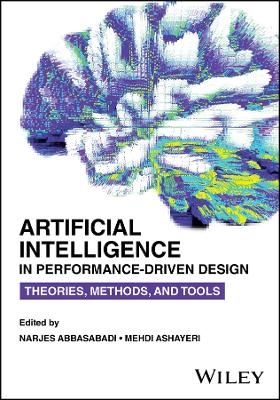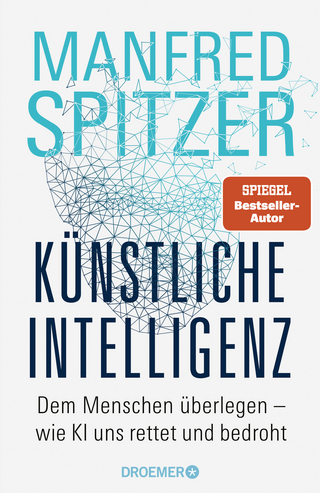
Artificial Intelligence in Performance-Driven Design
John Wiley & Sons Inc (Verlag)
978-1-394-17206-1 (ISBN)
Artificial Intelligence in Performance-Driven Design: Theories, Methods, and Tools explores the application of artificial intelligence (AI), specifically machine learning (ML), for performance modeling within the built environment. This work develops the theoretical foundations and methodological frameworks for utilizing AI/ML, with an emphasis on multi-scale modeling encompassing energy flows, environmental quality, and human systems.
The book examines relevant practices, case studies, and computational tools that harness AI’s capabilities in modeling frameworks, enhancing the efficiency, accuracy, and integration of physics-based simulation, optimization, and automation processes. Furthermore, it highlights the integration of intelligent systems and digital twins throughout the lifecycle of the built environment, to enhance our understanding and management of these complex environments.
This book also:
Incorporates emerging technologies into practical ideas to improve performance analysis and sustainable design
Presents data-driven methodologies and technologies that integrate into modeling and design platforms
Shares valuable insights and tools for developing decarbonization pathways in urban buildings
Includes contributions from expert researchers and educators across a range of related fields
Artificial Intelligence in Performance-Driven Design is ideal for architects, engineers, planners, and researchers involved in sustainable design and the built environment. It’s also of interest to students of architecture, building science and technology, urban design and planning, environmental engineering, and computer science and engineering.
Narjes Abbasabadi, PhD, is an Assistant Professor in the Department of Architecture at the University of Washington. Dr. Abbasabadi also leads the Sustainable Intelligence Lab (SIL). Her research centers on sustainability and computation within the built environment. Abbasabadi’s primary focus is advancing design research through the development of data-driven and physics-based methods, frameworks, and tools that leverage digital technologies, including artificial intelligence and machine learning, to enhance performance-based and human-centered design. With an emphasis on multi-scale exploration, her research investigates urban building energy flows, human systems, and environmental impacts across scales—from the scale of building to the scale of neighborhood and city. Abbasabadi’s research has been published in leading journals, including Applied Energy, Building and Environment, Energy and Buildings, Environmental Research, and Sustainable Cities and Society. Abbasabadi earned a Ph.D. in Architecture with a specialization in Technologies of the Built Environment, from the Illinois Institute of Technology, and holds Master’s and Bachelor’s degrees in Architecture from Tehran Azad University. Mehdi Ashayeri, PhD, is an Assistant Professor in the School of Architecture at Southern Illinois University, where he leads the Urban Intelligence and Integrity Lab (URBiiLAB). Ashayeri earned his Ph.D. in Architecture–Technologies of the Built Environment, from the Illinois Institute of Technology. He also holds an M.Sc. in Architectural Engineering and a B.Sc. in Civil Engineering from Tehran Azad University. Dr. Ashayeri’s research is centered on environmental performance and computing, with a strong emphasis on their implications for human health and justice. This involves developing frameworks, tools, and digital platforms using data-driven techniques including artificial intelligence, machine learning, natural language processing, Big data, and sensing, as well as physics-based simulation methodologies. In recent projects, Ashayeri has specifically explored spatiotemporal modeling, energy performance evaluation, assessment of exposure to air pollution, and the integration of human feedback systems across various scales. These studies are designed to facilitate data-informed decision-making for human-centered design, as well as to contribute to the development of sustainable buildings and cities. Ashayeri’s research has been published in high-impact journals, including Environmental Research, Energy and Buildings, Applied Energy, Building and Environment, and Sustainable Cities and Society.
List of Contributors xi
Introduction xiii
1 Augmented Computational Design 1
Introduction 1
Background 2
Relevance of AI in AEC 2
Historical Context 3
Design as Decision-Making 5
AI for Generative Design 7
Framework 9
Design Space Exploration 11
Spatial Design Variables 13
Statistical Approaches to Design 14
Demonstration 15
Case Study 15
Methodology 16
Results 21
BBN Validation Results 21
Toy Problem 22
Discussion 22
Outlook 25
Acronyms 26
Notations 27
References 28
2 Machine Learning in Urban Building Energy Modeling 31
Introduction 31
Urban Building Energy Modeling Methods 32
Top–Down Models 33
Bottom–Up Models 33
Uncertainty in Urban Building Energy Modeling 36
Epistemic Uncertainty 36
Stochastic Uncertainty 36
Addressing Uncertainty 37
Machine Learning in Urban Building Energy Modeling 39
Supervised Learning 39
Unsupervised Learning 44
Reinforcement Learning 46
Machine Learning-Based Surrogate UBEM 47
Conclusion 49
References 50
3 A Hybrid Physics-Based Machine Learning Approach for Integrated Energy and Exposure Modeling 57
Introduction 57
Materials and Methods 59
Data, Data Sources, and Dataset Processing 59
Methodology 61
Results 70
Physics-Based Simulation 70
Data-Driven Computation (Prediction) 70
Discussion 73
Conclusion 74
Acknowledgment 75
References 75
4 An Integrative Deep Performance Framework for Daylight Prediction in Early Design
Ideation 81
Introduction 81
Background 83
Daylight Simulation 84
Deep Learning Models 85
DL-Based Surrogate Modeling 85
Verification Methods 85
Research Methods 86
Data Acquisition 86
Model Training 88
Results and Validation 88
Discussions of Results 90
Conclusions 94
References 94
5 Artificial Intelligence in Building Enclosure Performance Optimization: Frameworks, Methods, and Tools 97
Building Envelope and Performance 97
Artificial Intelligence and Building Envelope Overview 97
Optimization Routes and Building Envelope 98
Optimization Frameworks 99
Optimization Methods 99
Machine Learning and Building Envelope 101
Artificial Neural Network 101
Convolutional Neural Network 105
Recurrent Neural Network 105
Generative Adversarial Networks 106
Ensemble Learning 107
Discussions on Practical Implications 108
Summary and Conclusion 109
References 110
6 Efficient Parametric Design-Space Exploration with Reinforcement Learning-Based Recommenders 113
Introduction 113
Methodology 115
Section 01: Clustering Design Options 116
Section 02: Reinforcement Learning-Based Recommender System 120
Design Dashboard 123
Discussion 124
Conclusion 125
References 126
7 Multi-Level Optimization of UHP-FRC Sandwich Panels for Building Façade Systems 129
Introduction 129
Building Façade Design Optimization 130
Methodology 134
Midspan Displacements and Thermal Resistivity of UHP-FRC Panels 136
Energy Performance of the UHP-FRC Panels at the Building Level 141
Life Cycle Cost Analysis of the UHP-FRC Panels 142
Surrogate Models 145
Multi-objective Optimization Algorithm 147
Results and Discussion 148
Surrogate Models 148
Pareto Front Solutions 151
Conclusion 152
References 153
8 Decoding Global Indoor Health Perception on Social Media Through NLP and Transformer Deep Learning 159
Introduction 159
Literature Review 161
Social Media and Urban Life: Theories, Challenges, and Opportunities 161
Methods for Computing Social Media Data in Environmental Studies 163
Materials and Methods 168
Data Query 168
Text Preprocessing 169
Text Tokenization 169
Text Summarization 170
Generating Co-occurrence Matrix 170
Sentiment Analysis and Classification 170
Visualizations 171
Embedding Visualization 171
Attention Score Visualization (Attention Map) and Interpretation 172
Results and Discussion 173
Conclusion 178
References 179
9 Occupant-Driven Urban Building Energy Efficiency via Ambient Intelligence 187
Introduction 187
Occupancy and Building Energy Use 191
Definitions 191
Occupant Monitoring Methods 193
Occupant Monitoring Via Observational Studies 194
Occupant Monitoring via Experimental Studies 195
Occupant-driven Energy Efficiency via Ambient Intelligence 196
Ambient Intelligence Advancements and Applications 196
AmI-Based Energy Efficiency Feedback (EEF) Systems 197
Energy Efficiency via AmI Systems and Digital Twins Technology 201
Conclusion 202
References 203
10 Understanding Social Dynamics in Urban Building and Transportation Energy Behavior 211
Introduction 211
Methodology 213
Modeling Framework 214
Explanatory Model 214
Data 215
Results and Discussion 219
Effects of Occupancy and Socio-economic Factors 219
Variable Importance (VI) 219
Lek’s Profile 219
Conclusion 226
References 227
11 Building Better Spaces: Using Virtual Reality to Improve Building Performance 231
Introduction 231
Applications of Virtual Reality in Building Performance 233
Virtual Reality for Improving Building Design through Integrated Performance Data 233
Virtual Reality for Building Design Reviews and Education in Architecture and Engineering 236
Virtual Reality for Research on Building Occupant Comfort and Well-Being 240
Conclusion 243
References 245
12 Digital Twin for Citywide Energy Modeling and Management 251
Introduction 251
Urban Building Energy Digital Twins (UBEDTs) 252
Definition and Conceptualization 252
Implications for Citywide Energy Management 254
Enabling Technologies 256
Twining Technologies 256
Urban Digital Twin(UDT) and Data Sources 258
Artificial Intelligence (AI) and Digital Twin 260
Relationship Between IoT, Big Data, AI–ML, and Digital Twins 261
Interoperability Technologies 262
Maturity Levels 263
Architecture 265
Data Acquisition Layer 266
Transmission Layer 266
Modeling and Simulation Layer 266
Data/Model Integration Layer 269
Service/Actuation Layer 269
Challenges in Implementing Citywide Digital Twins 269
Data Quality and Availability 270
Required Smart Infrastructure and Associated Cost 270
Interoperability 270
Data Analysis 271
Cybersecurity and Privacy Concerns 271
Conclusion 272
References 272
Index 277
| Erscheinungsdatum | 11.05.2024 |
|---|---|
| Verlagsort | New York |
| Sprache | englisch |
| Maße | 175 x 252 mm |
| Gewicht | 431 g |
| Themenwelt | Informatik ► Theorie / Studium ► Künstliche Intelligenz / Robotik |
| Technik ► Architektur | |
| ISBN-10 | 1-394-17206-0 / 1394172060 |
| ISBN-13 | 978-1-394-17206-1 / 9781394172061 |
| Zustand | Neuware |
| Haben Sie eine Frage zum Produkt? |
aus dem Bereich


